ex 1 pt.2 lab procedures
1/96
There's no tags or description
Looks like no tags are added yet.
Name | Mastery | Learn | Test | Matching | Spaced |
|---|
No study sessions yet.
97 Terms
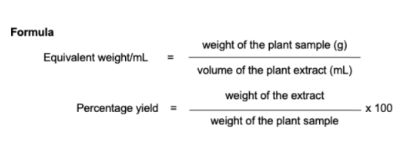
formulas
equivalent wt/ml
percentage yield
ALKALOIDS
basic nitrogenated compounds comprising the largest class of secondary plant metabolites
physiologically active
ALKALOIDS
usually occur in plants as their water-soluble salts
ALKALOIDS
form double salts with Hg, Au, Pt, and other heavy metals; these salts are obtained as precipitates which are micro- crystallographic
Hg, Au, Pt,
ALKALOIDS
form double salts with __ and other heavy metals; these salts are obtained as precipitates which are micro-crystallographic
micro-crystallographic
form double salts with Hg, Au, Pt, and other heavy metals; these salts are obtained as precipitates which are __
(+) cream color precipitate
positive result of Mayer’s Test
Mayer’s reagent (Potassium mercuric iodide TS)
reagent of Mayer’s test
(+) orange color precipitate
positive result of DRAGENDORFF’S TEST
Wagner’s reagent (Iodine in potassium iodide)
reagent of Wagner’s test
(+) reddish brown color precipitate
positive result of Wagner’s test
Valser’s reagent (Mercuric iodide TS)
Valser’s test reagent
(+) white color precipitate
positive result of Valser’s test
Hager’s reagent (Saturated solution of picric acid)
Hager’s test reagent
(+) yellow color precipitate
positive result of Hager’s test
GLYCOSIDES
plant constituents which produces sugars as products of hydrolysis
mineral acids
glycosides are hydrolyzed by boiling __
GLYCOSIDES
sugar ethers
GLYCOSIDES
regulatory, protective and sanitary compounds
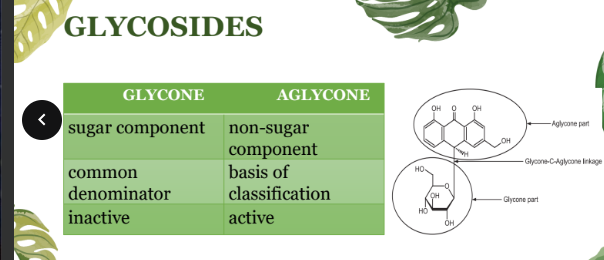
glycone
sugar component
common denominator
inactive
aglycone
non-sugar component
basis of classification
active
glycone / aglycone
CARDENOLIDE & BUFADIENOLIDE
steroidal glycosides also known as “cardiac glycosides”
CARDENOLIDE & BUFADIENOLIDE
have a prominent effect on the heart muscle
cyclopentanoperhydrophenanthrene nucleus (CPPP nucleus)
steroid structure of Cardenolide & Bufadienolide
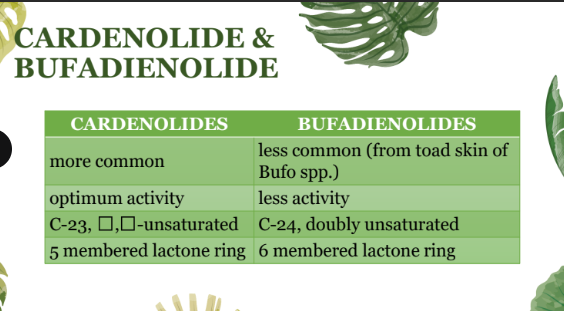
Cardenolides
more common
optimum activity
C-23, a, B- unsaturated
5 membered lactone ring
Bufadienlides
less common (from toad skin of Bufo spp.)
less activity
C-24, double unsaturated
6 membered lactone ring
cardenolides / bufadienolides
Bufadienolide
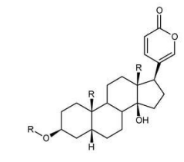
Cardenolide
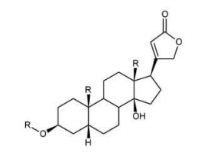
KELLER-KILIANI’S TEST
test for 2-deoxysugars
Ferric chloride TS (3 mL 1% FeCl3 in 50 mL glacial acetic acid)
reagent of Keller-Kiliani’s test
reddish-brown color, which may turn blue or purple
positive result of Keller- Kiliani’s test
LIEBERMANN-BURCHARD TEST
•test for unsaturated steroids and triterpenes
dichloromethane, acetic anhydride, conc. H2SO4
reagents of LIEBERMANN-BURCHARD TEST
colors ranging from blue to green, red, pink, purple or violet
LIEBERMANN-BURCHARD TEST positive result
KEDDE’S TEST
test for unsaturated lactones
Kedde’s reagent (1 g 3.5-dinitrobenzoic acid in positive50 mL methanol and 50 mL 2M KOH mixture)
reagent of Kedde’s test
blue-violet color
positive result KEDDE’S TEST
2 mL 0.025% digitoxin in methanol
positive standard of Kedde’s test
Salkowski’s test
test for sterols
conc. H2SO4
reagent of salkowski’s test
red layer in junction
positive result of salkowski’s test
ANTHRAQUINONE GLYCOSIDES
largest group of naturally occurring quinone pigments
ANTHRAQUINONE GLYCOSIDES
• occur as hydroxylated, methylated, or carboxylated derivatives of anthraquinones, anthrones, anthranal, or dianthrone
ANTHRAQUINONE GLYCOSIDES
O-glycosides or C-glycosides, or as their aglycones
ammonia solution (35.7 mL of 28% ammonia in 64.3 mL d. H2O)
reagent of Borntrager’s test
red coloration in the lower ammoniacal layer
positive result of borntrager’s test
0.5M KOH, 5% H2O2, glacial acetic acid, benzene, ammonia
reagent of MODIFIED BORNTRÄGER’S TEST
pink color
positive result of MODIFIED BORNTRÄGER’S TEST
flavonoids
phenolic plant pigments containing γ-benzopyrone nucleus
FLAVONOIDS
include anthocyanins, leucoanthocyanins, cathechins, aurones, chalcones
FLAVONOIDS
have reported anti-viral, anti-fungal, anti- inflammatory and cytotoxic activities
BATE-SMITH AND METCALF METHOD
test for leucoanthocyanins
conc. hydrochloric acid
reagent of BATE-SMITH AND METCALF METHOD
strong red or violet
positive result of BATE-SMITH AND METCALF METHOD
WILSTATTER “CYANIDIN” TEST
test for γ-benzopyrone nucleus
conc. hydrochloric acid, magnesium turnings, octanol
reagent of WILSTATTER “CYANIDIN” TEST
colors ranging from orange to red, to crimson and magenta, and occasionally to green or blue
positive result of WILSTATTER “CYANIDIN” TEST
SAPONINS
steroidal/triterpenoid glycosides characterized by their ability to froth when agitated
SAPONINS
exert a powerful hemolytic action on RBCs and are highly toxic when injected into the bloodstream
SAPONINS
has interesting spermicidal & molluscicidal activity
• steroidal – monocot (Dioscoreaceae)
• triterpenoid – dicot (Agavaceae)
two types of saponins
• Sarsaparilla – a beverage (root beer)
• Gugo – used as shampoo
• Ginseng – “drug for longevity”, adaptogen, tonic
other plants with saponins:
FROTHTEST
formation of persistent honeycomb froth upon shaking
the honeycomb froth is greater than 2 cm height from the surface of the liquid persists after 10 minutes
positive result of froth test
Na2CO3
froth test
for plant extracts with poor frothing effects, add a little 5% __ to basify the extract; the formation of a stable and dense froth indicates presence of free fatty acids
free fatty acids
froth test
for plant extracts with poor frothing effects, add a little 5% Na2CO3 to basify the extract; the formation of a stable and dense froth indicates presence of __
clear zones of hemolysis (hemolytic halos)
positive result of agad cup hemolytic test
TANNINS AND POLYPHENOLS
first applied to plant constituents capable of transforming raw animal skin into leather
TANNINS AND POLYPHENOLS
precipitates proteins, alkaloids and glycosides
tannic acid:
antidote for alkaloid poisoning
TANNINS AND POLYPHENOLS
acidic, sharp-puckering taste
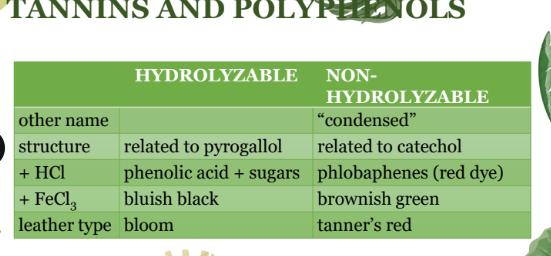
tannins anf polyphenols (hydrolyzable/non-hydrolyzable)
uses:tanning industry, treatment of burns, potential value as
cytotoxic and/or antineoplastic agents, astringent properties
use of tannins and polyphenols
polyphenols
have similarities to tannin structures; they are used as additives in tanning agents in the leather industry
gelatin-salt reagent(equal amount of 1% gelatin sol’n & 10% NaCl sol’n)
reagent of Gelatin test
formation of jelly-precipitate
positive result of gelatin test
iron (III) chloride, FeCl3 (3 mL 1% FeCl3 sol’n in 100 mL d. H2O)
ferric chloride test reagent
bluish black for hydrolysable tannins while brownish green for condensed tannins
ferric chloride test positive result
CYANOGENIC GLYCOSIDES
often found in legumes, root crops and grasses
CYANOGENIC GLYCOSIDES
usually found in plants together with hydrolytic enzymes
spontaneous hydrolysis
most cyanogenic glycosides are lost after plant harvest due to _
Manihot esculenta Crantz
the roots of __ (cassava), causes poisoning when eaten if tubers are half-cooked or cooked with intact root peelings
Prunus amydalus
__ (almonds) are also known to contain cyanogenic glycosides; emulsin hydrolyses glycosides
appearance of various shades of red within 15 mins when the tube is warmed (yellow to brick red)
positive result of GUIGNARD’S TEST
carbohydrates
most abundant group of organic molecules
• provide significant amount of energy; storage form of energy; cell component; structural component
monosaccharides
building blocks of carbohydrates
FEHLING’S TEST
test for reducing sugars (presence of aldehydes but not ketones)
brick red precipitate
positive result of Fehling’s test
MOLISCH TEST
test for pentoses and hexoses
bluish violet ring at the junction
positive result of molisch test
BENEDICT’S TEST
test for reducing sugars (monosaccharide or disaccharide containing hemiacetal or hemiketal group)
brick red precipitate
positive result of Benedict’s test
proteins
group of complex organic macromolecules that contain carbon, hydrogen, oxygen, nitrogen, and usually sulfur and are composed of one or more chains of amino acids
amino acids
building block of protein
flesh precipitate
positive result of millon’s test
yellow precipitate
positive result of Xanthoproteic test
lipids
any of a group of organic compounds, including the fats, oils, waxes, sterols, and triglycerides, that are insoluble in water but soluble in nonpolar organic solvents, are oily to the touch
GREASY SPOT TEST
extract dissolved in petroleum ether orhexane
greasy spot on paper
greasy spot test positive result